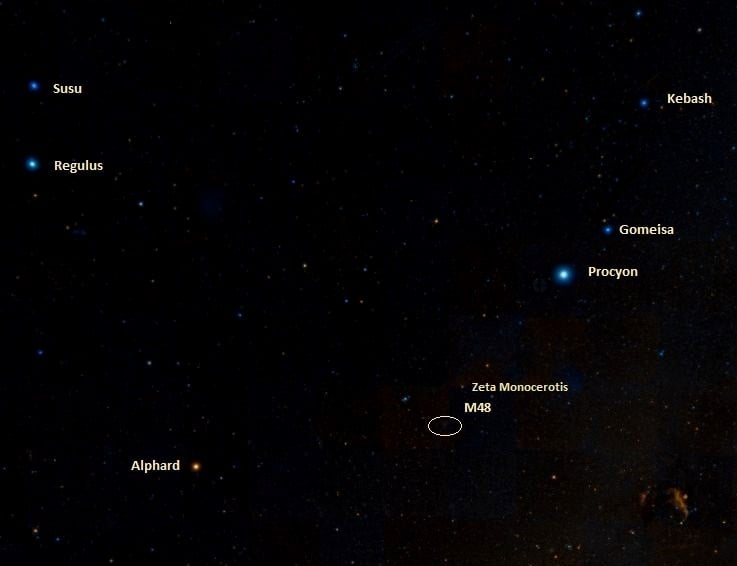Welcome back to Messier Monday! We continue our tribute to our dear friend, Tammy Plotner, by looking at the open star cluster of Messier 48. Enjoy!
In the 18th century, while searching the night sky for comets, French astronomer Charles Messier kept noting the presence of fixed, diffuse objects in the night sky. In time, he would come to compile a list of approximately 100 of these objects, with the purpose of making sure that astronomers did not mistake them for comets. However, this list – known as the
Messier Catalog
– would go on to serve a more important function.
One of these is the open star cluster known as Messier 48 (aka. NGC 2548). Located approximately 1,500 light years from Earth in the direction of the
Hydra constellation
, Charles Messier actually got the position of this cluster wrong, a mistake which was corrected by Caroline Herschel in 1783 (hence why she is sometimes credited with its discovery). This object is visible to the naked eye on a clear night, providing light conditions are favorable.
Description:
At a modest 300 million years old, this group of about 50 easily visible stars and 80 total members spans an area of space which covers 23 light years. By studying proper motion over time with an astrograph telescope, astronomers have determined it is roughly 1500 light years away from our solar system. But how are determinations like this made? By long term studies and painstaking photographic plates, which address which stars are moving, at what speeds, and in what direction.
[caption id="attachment_136195" align="aligncenter" width="580"]
The open star cluster Messier 48. Credit: Wikisky
[/caption]
As Z. Y. Wu of the Shanghai Astronomical Observatory indicated in a
2001 study
:
So now we understand how to determine distance, but how do astronomers determine age? As M. Hancock (et al) indicated in their
2008 study
:
[caption id="attachment_136196" align="aligncenter" width="580"]
Close up of the Messier 48 open star cluster. Credit: NASA
[/caption]
History of Observation:
According the SEDS, this open cluster was discovered by Charles Messier and cataloged by him on February 19, 1771. "Cluster of very small [faint] stars, without nebulosity; this cluster is at a short distance from the three stars that form the beginning of the Unicorn's tail."
However, as he did an error in data reduction, he gave a wrong position in his catalog so that the object was missing until Oswald Thomas identified it in 1934, and independently T.F. Morris in 1959. The identification of M48 by Oswald Thomas was confused by some historians, who have claimed erroneously instead that he had identified M47.
As M48 was lost, two independent rediscoveries occurred: First, Johann Elert Bode apparently found it in or before 1782, and second, Caroline Herschel independently rediscovered it in 1783; "March 8th [17]83. At an equal distance from 29 [Zeta] and 30 Monocerotis, making an equilateral triangle with those two stars is a nebulous spot. By the telescope it appears to be a cluster of scattered stars. It is not in Messier catalogue."
This latter discovery was published by Caroline's famous brother, William Herschel, who included it in his catalog as H VI.22 on February 1, 1786. "A beautiful Cluster of much compressed stars, considerably rich. 10 or 12' diameter. Caroline Herschel discovered it in 1783."
John Herschel would visit Messier 48 often in his NGC cataloging efforts, describing it as, "A superb cluster which fills the whole field; stars of 9th and 10th to the 13th magnitude - and none below, but the whole ground of the sky on which it stands is singularly dotted over with infinitely minute points [stars]. Place that of a bright star, the southern of two which point into the concavity of an arc."
[caption id="attachment_136198" align="aligncenter" width="580"]
Atlas Image mosaic of Messier 48 obtained as part of the Two Micron All Sky Survey (2MASS). Credit: UofMass/IPAC/Caltech/NASA/NSF
[/caption]
Once again, Messier's mistake would be missed when it was re-observed by Admiral Smyth, who described this object as follows:
Thanks to careful research done by Owen Gingerich in 1960, we now know exactly what happened:
May you find it a bit easier!!
Locating Messier 48:
The diamond-bright stars of winter help make locating M48 a little easier, as it is located just a little less than a hand span southeast of Procyon (Alpha Canis Minor) - or about 3 degrees southeast of Zeta Monocerotis. Like M44 in Cancer, M48 lies within the limits of unaided sight. It is quite large and will show several dozen stars easily to almost all binoculars and be well resolved in telescopes of any aperture. Be sure to use low magnification to see it best! Because Messier 48 is bright, it makes a fine object for urban sky conditions and moonlit nights.
[caption id="attachment_136193" align="aligncenter" width="580"]
The location of Messier 48 in the Hydra constellation. Credit: IAU/Sky & Telescope magazine (Roger Sinnott & Rick Fienberg)[/caption]
And here are the quick facts on this Messier Object to help you get started:
- Object Name
-
Messier 48
- Alternative Designations
-
M48, NGC 2548
- Object Type
-
Open Galactic Star Cluster
- Constellation
-
Hydra
- Right Ascension
-
08 : 13.8 (h:m)
- Declination
-
-05 : 48 (deg:m)
- Distance
-
1.5 (kly)
- Visual Brightness
-
5.5 (mag)
- Apparent Dimension
-
54.0 (arc min)
We have written many interesting articles about Messier Objects here at Universe Today. Here's Tammy Plotner's
Introduction to the Messier Objects
,
M1 – The Crab Nebula
, and David Dickison's articles on the
2013
and
2014
Messier Marathons.
Be to sure to check out our complete
Messier Catalog
. And for more information, check out the
SEDS Messier Database
.
Sources:
 Universe Today
Universe Today
